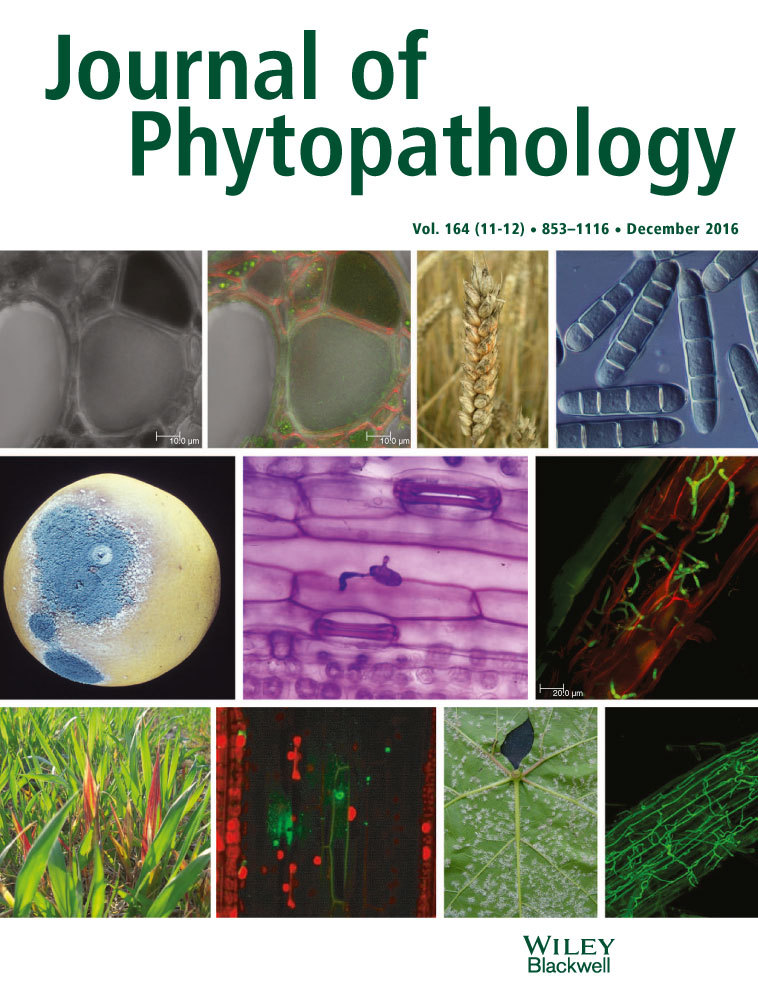Ver ítem
- xmlui.general.dspace_homeCentros Regionales y EEAsCentro Regional Salta - JujuyEEA SaltaArtículos científicosxmlui.ArtifactBrowser.ItemViewer.trail
- Inicio
- Centros Regionales y EEAs
- Centro Regional Salta - Jujuy
- EEA Salta
- Artículos científicos
- Ver ítem
Genetic characterization and pathogenicity of Rhizoctonia solani associated with common bean web blight in the main bean growing area of Argentina
Resumen
Common bean web blight (WB), caused by the fungus Rhizoctonia solani (teleomorph Thanatephorus cucumeris), is among the endemic fungal diseases of major impact in north‐western Argentina (NWA). This study aimed to analyse the genetic and pathogenic diversity of R. solani in Salta, NWA, where 97 isolates were recovered from commercial bean cultivars and wild beans showing WB symptoms in a major bean production area. The isolates were characterized on the
[ver mas...]
Common bean web blight (WB), caused by the fungus Rhizoctonia solani (teleomorph Thanatephorus cucumeris), is among the endemic fungal diseases of major impact in north‐western Argentina (NWA). This study aimed to analyse the genetic and pathogenic diversity of R. solani in Salta, NWA, where 97 isolates were recovered from commercial bean cultivars and wild beans showing WB symptoms in a major bean production area. The isolates were characterized on the basis of specific primers, rDNA‐ITS sequences and morphological characteristics. All the isolates were identified as R. solani AG 2‐2WB, and they exhibited considerable intragroup variation. The phylogenetic tree generated with the ITS sequences confirmed the isolates identification. Aggressiveness of the isolates towards bean seedlings was assessed in the greenhouse. A great variability in virulence was observed among the isolates analysed. On the basis of the disease reaction on foliar tissues, the isolates were grouped into three virulence categories as follows: weakly virulent (30%), moderately virulent (38%) and highly virulent (32%). However, no correlation between virulence and geographical origin was detected. The information generated in this study provides initial data on the population variability of the WB pathogen in north‐western Argentina and represents a valuable contribution to regional breeding programmes aimed to obtain cultivars with durable resistance.
[Cerrar]

Autor
Spedaletti, Yamila Andrea;
Aparicio Gonzalez, Monica Alicia;
Mercado Cardenas, Guadalupe Eugenia;
Rodriguero, Marcela Silvina;
Taboada, Gisel María;
Aban, Carla Luciana;
Sühring, Silvia Susana;
Vizgarra, Oscar Nicéforo;
Galvan, Marta Zulema;
Fuente
Journal of Phytopathology 164 (11-12) : 1054-1063 (December 2016)
Fecha
2016-12
ISSN
0931-1785
1439-0434
1439-0434
Formato
pdf
Tipo de documento
artículo
Palabras Claves
Derechos de acceso
Restringido
 Excepto donde se diga explicitamente, este item se publica bajo la siguiente descripción: Creative Commons Attribution-NonCommercial-ShareAlike 2.5 Unported (CC BY-NC-SA 2.5)
Excepto donde se diga explicitamente, este item se publica bajo la siguiente descripción: Creative Commons Attribution-NonCommercial-ShareAlike 2.5 Unported (CC BY-NC-SA 2.5)

